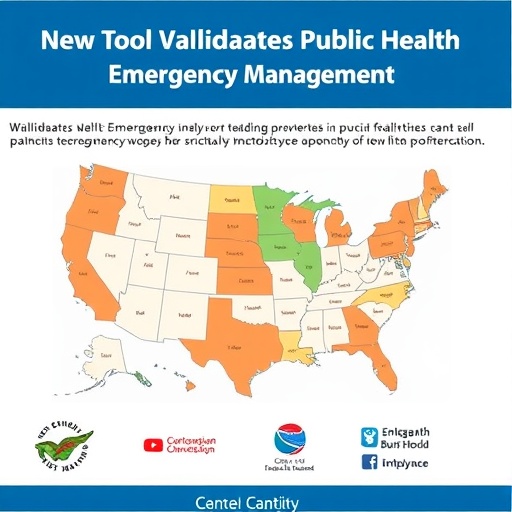In a rapidly evolving world where public health emergencies increasingly threaten global stability, an innovative breakthrough has emerged that promises to revolutionize how we respond to such crises. Researchers have developed and rigorously validated a novel assessment tool designed specifically to evaluate the effectiveness of public health emergency management programs. This pioneering initiative stands at the intersection of epidemiology, health policy, and crisis management, aiming to provide comprehensive metrics that can fundamentally improve emergency preparedness and response mechanisms worldwide.
The recent study, conducted by a team led by Sasie, Ayano, and Girma, published in Global Health Research and Policy, addresses a critical gap in public health infrastructure. Historically, the ability to critically appraise emergency management programs has been fragmented, limited by inconsistencies in evaluation criteria and a lack of standardized tools. This new assessment instrument introduces a structured, scalable, and scientifically robust framework that empowers policymakers and health administrators alike to systematically measure capacities, identify vulnerabilities, and craft targeted interventions.
At its core, the assessment tool is built on a multifaceted evaluation model encompassing preparedness, response, recovery, and mitigation phases of public health emergencies. Unlike previous tools that tended to focus narrowly on isolated aspects, this comprehensive approach ensures that every stage of emergency management is scrutinized. By integrating qualitative and quantitative data streams, the instrument facilitates nuanced insights that transcend traditional checklists or self-reported surveys.
Technically, the development process utilized advanced psychometric methodologies, including factor analysis and Cronbach’s alpha tests, to ensure reliability and validity. The researchers undertook an extensive field validation phase involving multiple public health agencies across diverse geopolitical settings. This rigorous validation confirmed that the tool can adapt to varying contexts, be it a localized outbreak or a mass casualty event, without sacrificing precision or predictive power.
Functionally, the tool incorporates dynamic scoring algorithms that weigh different management components based on contextual risk assessments and past performance metrics. This adaptability not only enhances accuracy but also allows for real-time monitoring and iterative improvement plans. Emergency managers can now identify priority gaps within their systems and allocate resources more efficiently, transforming raw data into actionable intelligence.
Another standout feature is the integration of user-friendly digital interfaces that facilitate widespread adoption among health professionals, especially in resource-limited settings. The tool’s developers emphasized accessibility, ensuring compatibility with mobile and web platforms, thus enabling field operatives to conduct rapid assessments even during ongoing emergencies. This connectivity fosters better communication flows between frontline teams and central command, streamlining coordination efforts.
Importantly, this novel tool emerges against the backdrop of an increasingly interconnected global health landscape, where disease outbreaks can escalate into pandemics with unprecedented speed. Earlier spikes in pandemics—ranging from SARS and Ebola to COVID-19—have exposed grave deficiencies in emergency preparedness. The introduction of this assessment framework can be viewed as a direct response to these lessons, underscoring the necessity of evidence-based strategies in combating emerging health threats.
Public health experts have hailed the tool as a potential game-changer for enhancing resilience. By offering clear, empirically backed evaluations, it promotes accountability and continuous improvement, which are vital for sustaining long-term public health security. Health ministries and international organizations are already exploring partnerships to integrate this tool into existing emergency management platforms and training curricula.
Moreover, the implications extend beyond immediate emergency response. The tool’s analytical capacity supports scenario planning and simulation exercises, enabling stakeholders to model potential outcomes under different crisis scenarios. This forward-looking capability empowers decision-makers to anticipate challenges and optimize contingency plans, thereby saving lives and minimizing economic disruption when crises unfold.
The ethical considerations embedded within the tool’s design are also commendable. It respects data privacy and ensures transparency in reporting results, fostering trust among communities and stakeholders. Such principles are fundamental for maintaining public confidence and compliance during the chaotic phases of health emergencies.
Collaborative efforts in developing this tool reflect a multidisciplinary synergy involving epidemiologists, statisticians, software engineers, and policy analysts. Their collective expertise underscores the complexity of emergency management and the necessity of integrating diverse perspectives to craft effective solutions. This multidisciplinary model serves as a blueprint for future innovations in public health.
Looking forward, the researchers envision iterative enhancements driven by continuous feedback loops from end-users. Plans include incorporating machine learning algorithms that can refine assessments based on incoming data streams, thus evolving the tool into a smarter, more predictive system. The commitment to continuous improvement ensures that the tool remains relevant amidst shifting epidemiological landscapes.
As global health authorities evaluate new protocols in the wake of recent crises, this assessment tool arrives as an indispensable asset—transforming the way societies prepare for, respond to, and recover from public health emergencies. The fusion of empirical rigor, technological ingenuity, and practical applicability places it at the forefront of modern epidemiological defense strategies.
Ultimately, the development and validation of this public health emergency management assessment tool signify a monumental stride in safeguarding global health. It equips stakeholders with sharper insights, bolsters coordination efforts, and fosters resilience against future outbreaks. The impact of this advancement will resonate for years to come as the world grapples with the persistent and evolving challenge of public health emergencies.
Subject of Research:
Development and validation of an assessment tool for evaluating public health emergency management programs.
Article Title:
Development and validation of an assessment tool for public health emergency management program.
Article References:
Sasie, S.D., Ayano, G., Girma, M. et al. Development and validation of an assessment tool for public health emergency management program. Global Health Research and Policy 10, 44 (2025). https://doi.org/10.1186/s41256-025-00423-z
Image Credits: AI Generated




